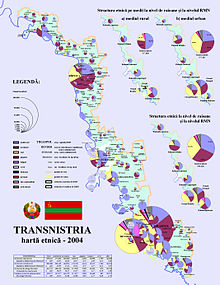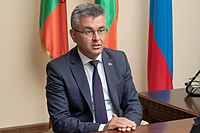Proposed Russian annexation of Transnistria
The government of Transnistria, a breakaway state internationally recognized as part of Moldova, has requested annexation by Russia numerous times. Transnistria is a territory that separated itself from Moldova due to fear of a possible unification of the latter with Romania. This sparked the Transnistria War, in which Russian-backed Transnistria managed to stay separate from Moldova. Despite this, today Transnistria is legally and internationally considered part of Moldova.
Following Russia's annexation of Crimea in 2014, hopes in Transnistria that Russia would annex its territory as well grew. Transnistria has a substantial ethnic Russian population and the vast majority of its people speak Russian. The territory is financially supported by Russia, and Transnistrian education and laws are also interrelated with Russia. In 2006, a referendum in Transnistria was organized by the first President of Transnistria Igor Smirnov to vote for a possible reintegration into Moldova or independence and a future accession to the Russian Federation. The former proposal was rejected and the latter was approved, although the veracity of these results has been questioned. Still, posterior studies have proven the popularity of the idea on at least part of the population of Transnistria.
Due to all this, exactly on the same day that Russia annexed Crimea, the leader of the Transnistrian parliament Mikhail Burla sent a letter to Russia requesting the facilitation of a Russian annexation of Transnistria in the country's laws, which had a negative response from the international community. The topic was mentioned on numerous more occasions by different Transnistrian politicians such as the former Minister of Foreign Affairs of Transnistria Nina Shtanski, the former Transnistrian president Yevgeny Shevchuk (who issued an unsuccessful decree in 2016 to eventually make Transnistria join Russia) and the current one, Vadim Krasnoselsky. Some figures from Russia such as Zakhar Prilepin, Vladimir Zhirinovsky and the For Truth party have responded positively to such a possibility.
Several analysts, however, believe that Russia will not try to annex Transnistria. Russia officially strives for the granting of a special status of Transnistria within Moldova, possibly to exert influence over the entire country. An annexation of Transnistria by Russia would be counterproductive to this goal, especially considering that it could accelerate an undesired unification between Moldova and Romania. Furthermore, Transnistria is far from Russia and landlocked, and creating a nationalist discourse among the Russian people to achieve annexation, as was done before with Crimea, could be more difficult.
Background

Following the
Following the end of the war, there were attempts at resolving the Transnistria conflict, most notably the Kozak memorandum, but none were successful.[1][2] On 17 September 2006, a referendum in Transnistria was held by the authorities of the state. It asked the population whether Transnistria should be reintegrated into Moldova or not and whether it should seek independence and a potential future integration into Russia or not. 96.61% rejected the first question and 98.07% approved the second one, with the voter turnout being of 78.55%.[3] However, the Moldovan branch of the Helsinki Committee for Human Rights claimed to have detected irregularities and infringements in the referendum and suggested that the results could have been prepared beforehand.[4] The president at this time was Transnistria's first, Igor Smirnov. Smirnov suggested and referenced a possible Transnistrian accession to Russia a number of times during his 20-year long rule.[5]
According to the 2015 Transnistrian census, Transnistria is a Russian-plurality territory, with 34% of the population identifying as Russians, 33% Moldovans/Romanians and 26.7% Ukrainians. The rest of the population that declared its ethnicity, belong to smaller minorities. Bulgarians polled 2.8%, Gagauz people 1.2%, Belarusians 0.6%, Germans 0.3% and Poles 0.2%, among others.[6] There are however claims that Moldovans/Romanians represent in fact 40% of the population.[7][8]
Proposals
History

Following Russia's formal
Days later, Nina Shtanski, then Minister of Foreign Affairs of Transnistria, approved the annexation of Crimea, declared that "we consider ourselves part of the Russian world" and that "we are no different from Russians and Russian civilization" and requested the President of Russia Vladimir Putin to annex Transnistria.[18] Posteriorly, in April 2014, Transnistrian parliamentaries called on Russia to recognize Transnistrian independence.[19]
On 7 September 2016, the then President of Transnistria
Shevchuk's successor as the President of Transnistria, Vadim Krasnoselsky, expressed in 2018 his commitment to make Transnistria join Russia in the future.[24] He also said in 2019 that Russia "is our destiny" and that a possible new referendum on a possible unification with Russia could be held if needed, but on the condition that Russia would recognize the results.[25]
Analysis
Russian influence over Transnistria is big, with around 200,000 Transnistrians having a
The proposal has received support in Russia. For example, the Russian politician Vladimir Zhirinovsky, leader of the Liberal Democratic Party of Russia (LDPR) and former deputy chairman of the State Duma, stated that Russia should recognize and defend Transnistria.[28] He has also stated that Transnistria "is Russian territory".[29] The former Russian party For Truth also supported Russian recognition and annexation of Transnistria.[30] The Russian writer Zakhar Prilepin is another figure that has striven for the Russian annexation of Transnistria, as well as Abkhazia, the Republic of Artsakh, South Ossetia, Donetsk and Luhansk.[31]
However, some analysts and scholars have claimed that a Russian annexation of Transnistria is unlikely. Russia does not recognize Transnistria as an independent country unlike other breakaway states such as Abkhazia and South Ossetia, recognized by it in 2008, and has shown no interest in doing so.
See also
- Reintegration of Transnistria into Moldova
- Russia–Transnistria relations
- Proposed Russian annexation of Abkhazia
- Proposed Russian annexation of South Ossetia
- Territorial evolution of Russia
- Russian annexation of Donetsk, Kherson, Luhansk and Zaporizhzhia oblasts
- Russian irredentism
- "Near abroad"
- Russian-occupied territories
- "
References
- ^ from the original on 6 June 2021. Retrieved 6 June 2021.
- ^ from the original on 14 February 2022. Retrieved 6 June 2021.
- from the original on 6 June 2021. Retrieved 6 June 2021.
- ^ "HCHRM claims a series of infringements at the referendum on independence in Transnistria". IPN. 18 September 2006. Archived from the original on 6 June 2021. Retrieved 6 June 2021.
- from the original on 14 February 2022. Retrieved 6 June 2021.
- ^ "Статистический ежегодник 2017" (in Russian). Ministry of Economic Development of Transnistria. Archived from the original on 26 October 2019. Retrieved 6 June 2021.
- S2CID 146854881.
- from the original on 6 June 2021. Retrieved 6 June 2021.
- ^ a b c d e f g Kolstø, Pål (11 June 2014). "Transnistria is a bridge too far for Russia". openDemocracy. Archived from the original on 6 June 2021. Retrieved 6 June 2021.
- ^ Gardner, Andrew (19 March 2014). "Russia to annex Transnistria?". Politico. Archived from the original on 6 June 2021. Retrieved 6 June 2021.
- ^ Bocharova, Svetlana; Biryukova, Liliya (18 March 2014). "Приднестровье как Крым". Vedomosti (in Russian). Archived from the original on 11 December 2021. Retrieved 6 June 2021.
- ^ "Moldova's Trans-Dniester region pleads to join Russia". BBC. 18 March 2014. Archived from the original on 4 January 2022. Retrieved 6 June 2021.
- ^ "Transnistria wants to merge with Russia". Vestnik Kavkaza. 18 March 2014. Archived from the original on 4 November 2021. Retrieved 6 June 2021.
- ^ Porzucki, Nina (24 March 2014). "Where's Transnistria? And why do people there hope Russia will annex them next?". Public Radio International. Archived from the original on 6 June 2021. Retrieved 6 June 2021.
- ^ "Președintele Nicolae Timofti avertizează Rusia să nu încerce să anexeze regiunea transnistreană". Radio Europa Liberă Moldova (in Romanian). 18 March 2014. Archived from the original on 6 June 2021. Retrieved 6 June 2021.
- ^ Călugăreanu, Vitalie (19 March 2014). "Chișinăul vrea să știe unde se va opri Rusia". Deutsche Welle (in Romanian). Archived from the original on 6 June 2021. Retrieved 6 June 2021.
- ^ "Romania calls to "accelerate" Moldovan access to the EU while Transnistria turns again eyes to Moscow". Nationalia. 20 March 2014. Archived from the original on 6 June 2021. Retrieved 6 June 2021.
- ^ Marin, Viorica (24 March 2014). "Nina Ștanski, "ministrul de Externe" de la Tiraspol, îi cere lui Vladimir Putin să anexeze Transnistria". Adevărul (in Romanian). Archived from the original on 6 June 2021. Retrieved 6 June 2021.
- ^ Matveyeva, Polina; Braterskiy, Alexander; Galimova, Natalia (17 April 2014). "Приднестровье хочет от Путина признания". Gazeta.Ru (in Russian). Archived from the original on 6 June 2021. Retrieved 6 June 2021.
- ^ "Президент Приднестровья издал указ о подготовке к присоединению к России". Russia-24 (in Russian). 9 September 2019. Archived from the original on 6 June 2021. Retrieved 6 June 2021.
- ^ Hromadske.TV (in Russian). 13 September 2016. Archivedfrom the original on 6 June 2021. Retrieved 6 June 2021.
- ^ Baranova, Maria; Braterskiy, Alexander (9 September 2016). "Приднестровье хочет в Россию". Gazeta.Ru (in Russian). Archived from the original on 8 August 2021. Retrieved 6 June 2021.
- ^ "В ПМР российский флаг разрешили использовать наравне с государственным" (in Russian). RIA Novosti. 12 April 2017.
- ^ "МИР Глава Приднестровья заявил о приверженности курсу на присоединение к России". Izvestia (in Russian). 2 September 2018. Archived from the original on 7 June 2021. Retrieved 6 June 2021.
- ^ "Вадим Красносельский: "Россия — это наша судьба"". Federal News Agency (in Russian). 10 December 2019. Archived from the original on 6 June 2021. Retrieved 6 June 2021.
- ^ from the original on 14 February 2022. Retrieved 6 June 2021.
- ^ Cojocari, Tatiana; Cupcea, Radu; Dungaciu, Dan (2019). "Perceptions, attitudes and values of the population from the left bank of Dniester river. Part I." A Demystified Transnistria. Giving the Public Opinion a Voice. Black Sea University Foundation.
- ^ Botnarenco, Iurii (18 November 2020). "Primele atacuri din Rusia după victoria Maiei Sandu. Jirinovski: Chișinăul va încerca să ocupe Transnistria pe cale militară. Trebuie să o apărăm". Adevărul (in Romanian).
- ^ a b Stroe, Daniel (24 March 2014). "Russian firebrand proposes Romania to take a portion of Ukraine". Independent Balkan News Agency. Archived from the original on 6 June 2021. Retrieved 6 June 2021.
- ^ "В России призвали признать Приднестровье и провести референдум о включении в состав РФ". Novosti Pridnestrovya (in Russian). 7 July 2020. Archived from the original on 14 February 2022. Retrieved 6 June 2021.
- ^ "Прилепин призвал присоединить к России Донбасс, Приднестровье и Карабах". National News Service (in Russian). 4 February 2014. Archived from the original on 6 June 2021. Retrieved 6 June 2021.



